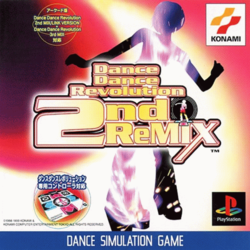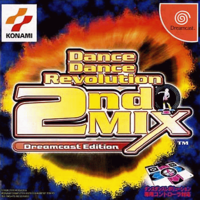- Dance Dance Revolution 2ndMix
-
Dance Dance Revolution 2ndMix 
Artwork for the PlayStation port of Dance Dance Revolution 2ndMix, titled 2ndReMix. Mentioning the ability to share data between the PlayStation games and properly equipped arcade machines.Developer(s) Konami Computer Entertainment Tokyo Publisher(s) KCET Distributor(s) KCET Designer(s) KCET Series Dance Dance Revolution & Bemani Engine 2ndMix & 2ndMix PlayStation Platform(s) Arcade, PlayStation, Dreamcast Release date(s) Arcade: - JP January 29, 1999
PlayStation:
- JP August 26, 1999
Dreamcast:
- JP February 17, 2000
Genre(s) Music & Exercise Mode(s) Single-player & Multiplayer Rating(s) CERO: A (PlayStation) Media/distribution CD-ROM Cabinet Custom Arcade system Bemani System 573 Analog CPU R3000A 32 bit RISC processor Sound PlayStation SPU Display 29" CRT (Raster, 256x224 & 740x480) Dance Dance Revolution 2ndMix, or 2ndMix, is the 2nd game in the Dance Dance Revolution series of music video games. It was released as an arcade game by Konami on January 19, 1999. Although only officially released in Japan, units exist worldwide. It has a total of 36 songs: ten from the original Dance Dance Revolution arcade game and 26 all-new songs.
Contents
Gameplay
See also: Gameplay of Dance Dance RevolutionThe core gameplay and scoring system of 2ndMix is the same as the previous version of Dance Dance Revolution.
The arrows in 2ndMix do not have different color-cycles based on their time signature. The "Vivid" arrow colors familiar to players of later mixes were not introduced until the club versions.
Link Version
Dance Dance Revolution 2ndMix Link Version, released on April 21, 1999, introduced the ability for players to save high scores and play custom step edits using their PlayStation memory cards. A player would first need to format the memory card with "Link Data" using the home version of 2ndMix, and then insert the card into one of two slots on the front of the arcade cabinet. Link Version includes 5 new songs, in addition to the full 2ndMix song list. After the release of Link Version, Link Data features had been implemented in every future DDR version until Dance Dance Revolution SuperNOVA (which was originally said to contain support for PlayStation 2 memory cards, but the functionality was removed), which has new network support over e-Amusement for saving statistics and unlocks.
Home versions
Dance Dance Revolution 2ndReMix, the home version of 2ndMix, was released in Japan on August 26, 1999, for the Sony PlayStation. It includes 34 songs, seven of which are new to this version and are hidden and unlockable. Two of the hidden songs were previews of the next arcade version, Dance Dance Revolution 3rdMix and can only be played on Basic difficulty.
On February 17, 2000, Konami released a version of Dance Dance Revolution 2ndMix for the Dreamcast console. It features 43 songs, seven of which are hidden and unlockable. The song list includes seven songs from Dance Dance Revolution 3rdMix.
A few of the songs in 2ndMix were included in the North American version of Dance Dance Revolution for the PlayStation.
Music
Soundtrack
The original soundtrack for 2ndMix was produced by Toshiba EMI under their Dancemania dance music brand. It featured 32 of the songs in the game. It also came with a second disk that featured a "Nonstop Megamix" with the various songs mixed together in succession. It was released on April 28, 1999. Toshiba EMI also announced that they will re-release the original soundtrack to promote the release of Dance Dance Revolution X3 VS 2ndMIX (in which the game include DDR 2ndMIX) on November 30, 2011.
References
External links
- Dance Dance Revolution 2ndMix official website (Japanese)
- Dancemania (Japanese)
Preceded by
Dance Dance RevolutionDance Dance Revolution 2ndMix
1999Succeeded by
Dance Dance Revolution 3rdMixCategories:- 1999 video games
- Arcade games
- Dance Dance Revolution games
- Dreamcast games
- PlayStation games
- Video games developed in Japan
- Japan-exclusive video games
Wikimedia Foundation. 2010.

